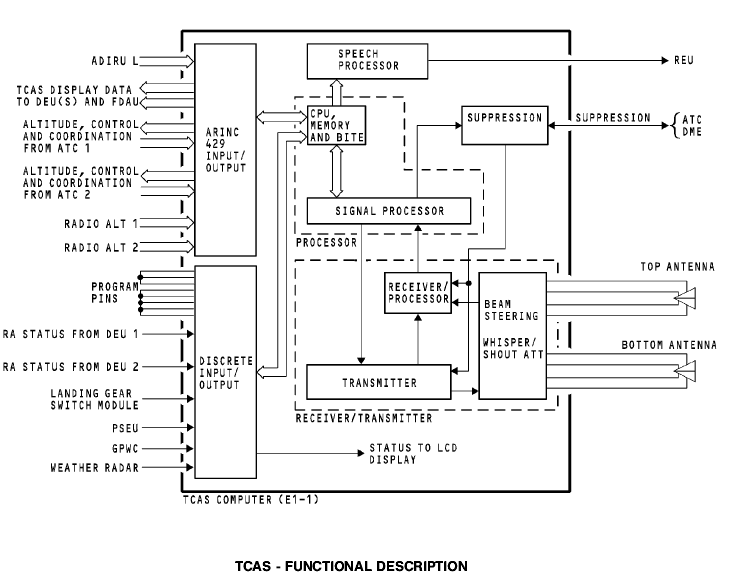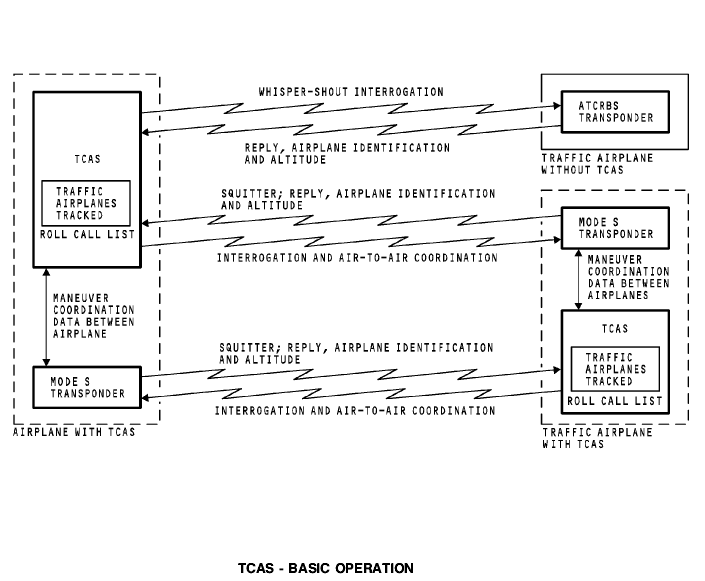
- •Traffic alert and collision avoidance system General
- •Abbreviations and Acronyms
- •Tcas - general description General
- •Tcas - component location General Description
- •Radio Altimeter Inputs
- •Signal Processor
- •Suppression
- •Speech Processor
- •Receiver Processor
- •Transmitter
- •Beam Steering and Attenuator Circuits
- •Directional Antenna
- •Tcas - basic operation General
- •Whisper-Shout Interrogation
- •Mode s Interrogation
- •Tcas Data Calculation
- •Tcas - surveillance area General
- •Ra and ta Groups
- •Atc/tcas Control Panel
- •Tcas - navigation display General
- •Range Data
- •Altitude Readout
- •Altitude Separation
- •Absolute Altitude
- •Vertical Motion Arrow
- •Tcas Messages
- •Offscale
- •Traffic
- •Ra and ta No-Bearing Traffic
- •Corrective Action ra
- •Corrective Action ra
- •Increase Corrective Action ra
- •Tcas Self-Test Indications – ai
- •Tcas - self-test indications on tcas computer front panel Front Panel Self-Test
Directional Antenna
The directional antenna has four elements spaced 90 degrees apart. Each element is independent of the others and has it own coaxial connector.

Tcas - basic operation General
TCAS transmits these two types of interrogation signals:
Whisper-shout for ATCRBS transponders
Mode S.
The TCAS finds and monitors all of the airplanes within range that have ATCRBS or mode S transponders. The TCAS operates with its mode S transponders to interrogate traffic airplanes and calculate if they are a threat. The TCAS does not track airplanes that do not have a transponder. The TCAS tracks airplanes with transponders that do not reply with mode C information. These airplanes send framing pulses in response to a mode C interrogation. The TCAS uses the framing pulse replies to give range and bearing to the target. TCAS cannot give RAs for targets that do not report altitude.
The TCAS can calculate maneuver commands to prevent
possible collisions with target airplanes.
If the traffic airplane also has TCAS, the two airplanes can agree on maneuvers that give a safe distance between them.
Whisper-Shout Interrogation
The TCAS uses an ATCRBS all-call whisper-shout interrogation to look for airplanes that have an ATCRBS transponder. The whisper-shout procedure changes the strength of the interrogation pulse in many steps. This lets TCAS interrogate intruders at different ranges. Intruders that reply are put on the TCAS roll call list and TCAS monitors them.
The airplanes that are near receive the lower power (whisper) interrogations. The airplanes that are far away do not receive these low power signals so they do not respond.
The TCAS transmits a suppression pulse as the interrogation power increases. The airplanes that are farther away receive the higher power (shout) interrogations. The airplanes that are near receive the interrogation and the suppression pulse so they do not reply.
Mode s Interrogation
Mode S transponders transmit a squitter signal once each second. The signals contain a 24-bit airplane address. The TCAS listens for mode S squitter signal transmissions from airplanes that have mode S transponders. When the TCAS receives an address, it puts that airplane on a roll call list. The TCAS then interrogates the mode S transponder of the traffic airplane with the discrete 24-bit airplane address on the roll call list.
Tcas Data Calculation
When the TCAS interrogates a target, the reply signal from the target usually contains the airplane altitude and any information requested by TCAS.
The TCAS computer uses the round-trip time of the reply signal to calculate the range and range rate of the target. It uses the direction of the reply to calculate bearing of the target. If the TCAS computer receives altitude data, it calculates these parameters of the traffic airplane:
altitude
altitude rate
relative altitude.
The TCAS computer uses the target data to calculate if the target is on a possible collision or near collision course with its flight path. If it is, the TCAS computer calculates traffic coordination maneuver data. This data and the position data go to the DEUs to make the TCAS displays. If TCAS advises that a maneuver be made it also sends an aural command to the flight crew.
Air-to-Air Coordination
If the target also has TCAS, the two TCAS computers communicate with each other using the mode S transponders. Both TCAS computers calculate an escape path if it is necessary. Both TCAS computers send the escape path to the mode S transponder in the other airplane. This sets up the airto-air mode S data link between the airplanes.

